Imagine the FREEDOM
from Contacts and Glasses
Over the last decade, laser vision correction with LASIK and ASA-PRK has helped millions of people see without glasses or contact lenses. Thanks to new advances in laser technology, LASIK and ASA-PRK now offer a solution for patients with myopia (nearsightedness), hyperopia (farsightedness), and astigmatism.
At White Eye Associates, our eye surgeon is known for achieving excellent results with LASIK eye surgery. If you are considering laser vision correction, please read the information featured on this page and contact White Eye Associates today for a complimentary initial laser vision correction screening, or for a comprehensive surgical consultation.
- What is excimer laser surgery
- The history of excimer laser
- Photorefractive Keratectomy (PRK)
- Laser Assisted In-Situ Keratomileusis (LASIK)
- What is the Allegretto Wave excimer laser system?
- How does the Allegretto Wave differ from other laser eye treatments?
- Who may have excimer laser surgery?
- What is the process?
- Laser Day
- What is involved in the Allegretto Wave procedure?
- How LASIK works
- What is involved in the PRK procedure?
- How long does the treatment take? How long will recovery be?
- How do I know it’s safe?
- Will I be in any pain?
- What are the side effects?
- Will the treatment be permanent?
- Can I afford the treatment?
What is excimer laser surgery?
Excimer laser refractive surgery is an outpatient microsurgical procedure to correct nearsightedness (myopia) by changing the shape of the cornea of the eye so that light rays may focus properly on the back of the eye. The procedure takes about 10 – 15 minutes per eye, depending on the degree of the correction required. It is performed in our office, requires no stitches, and involves very little or no pain.
The history of excimer laser
Laser correction of nearsightedness is a thoroughly tested and clinically proven treatment. Over 2,500 treatments were performed in the U.S. clinical trials for safety and effectiveness. After extensive testing and follow-up over a six-year period, the excimer laser has been proven safe and effective for the treatment of the large majority of nearsighted prescriptions as determined by the FDA. Millions of laser treatments have been done in the U.S. since 1996.
Photorefractive Keratectomy (PRK)
PRK uses the laser to reshape the corneal surface. The surface layer of cells, or the epithelium, is gently removed from the eye. Then the laser is used to reshape the surface. PRK has a longer recovery period than LASIK, but a better safety profile.
Laser Assisted In-Situ Keratomileusis (LASIK)
LASIK uses the excimer laser to gently remove a thin layer of corneal tissue, not on the surface, but under a thin flap of corneal tissue. The flap is made with a special shaving device, designed to gently create a reliable thin flap of cornea in seconds. Once the flap is laid aside, the corneal bed is then lasered and the flap is replaced. The flap heals overnight, and there are no sutures required.
What is the Allegretto Wave excimer laser system?
The Allegretto Wave system is the newest technology, offering the most advanced excimer laser treatment available today. This unique system combines active eye-tracking and small-beam corneal shaping, providing a new level of accuracy and precision.
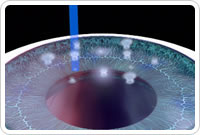 How does the Allegretto Wave differ from other laser eye treatments?
How does the Allegretto Wave differ from other laser eye treatments?
The Allegretto Wave uses a laser radar system developed by NASA that follows, or “tracks”, eye movement at a rate of 200 times per second, eight times faster than some of the competition. This is much improved over video-based lasers, checking eye movement only 60 times per second. All patients during surgery experience some eye movement during the procedure. These movements can affect the placement of the laser beam and can result in decreased visual acuity following the procedure.
The new Allegretto Wave system allows the patient to completely relax during the procedure and know they will get the best possible results. Allegretto Wave’s cool, Gaussian beam gives an increased accuracy in corneal shaping, removing less corneal tissue than the width of a human hair. Realigning with each laser pulse, the Allegretto Wave system guides the placement of the laser beam to a predetermined location on the cornea.
Why is tracking important?
Tracking is important because the laser is able to track the position of the eye 1000 times per second. It can track the eye faster than the eye can move, which is important so all the laser spots are placed accurately.
Who may have excimer laser surgery?
Each person suffers from a different degree of nearsigntedness, farsightedness, or astigmatism. The success will vary somewhat depending on:
- The amount of correction
- The general health of the eye
Patients should have a prescription that has been stable for 12 months and should be over the age of 21. The best candidates have:
- A Disease-free Cornea
- Myopia between -1.00 and -13.00 with up to 6 Diopters of Astigmatism
- Hyperopia between +1.00 and +6.00 with up to 6 Diopters of Astigmatism
- Problems Wearing Contact Lenses
- Problems with glasses interfering with Professional and/or Social lifestyle
- No other problem which affects the general health of the eyes
What is the process?
The first step is a presurgical consultation in our office or your optometrist’s office. This provides a complete explanation of PRK and LASIK, the benefits, risks, and alternatives. An evaluation with corneal topography provides computerized color printouts of the cornea’s surface, which help to determine your candidacy for surgery and aid in calculations for surgery. You should not wear hard contacts lenses six weeks prior to your evaluation or soft contacts three days before the evaluation.
When your laser is scheduled, you will be given a list of instructions that you must follow prior to having laser. The instructions emphasize that you should not wear hard contact lenses six weeks prior to your surgery or soft contacts 24 hours before the surgery.
Laser Day
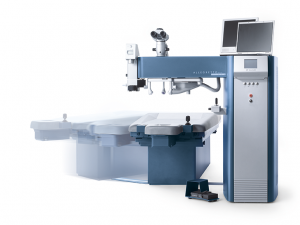 Your laser treatment is performed right here in our office in the surgical suite, and family and friends are welcome to accompany you. Patients must not be wearing any perfumes, aftershave, or strong smelling lotions or creams. (If you can smell it, it will affect the laser beam.) Once you arrive on the day of surgery, drops will be placed in your eye, and you will be given a mild sedative to help you relax.
Your laser treatment is performed right here in our office in the surgical suite, and family and friends are welcome to accompany you. Patients must not be wearing any perfumes, aftershave, or strong smelling lotions or creams. (If you can smell it, it will affect the laser beam.) Once you arrive on the day of surgery, drops will be placed in your eye, and you will be given a mild sedative to help you relax.
What is involved in the Allegretto Wave procedure?
The doctor will take a picture of your eye to help the laser to determine the exact dimensions of your eye. You will be taken into the Allegretto Wave suite. You will lie down on the table, as the doctor looks into your eye through a microscope. The Allegretto Wave system will confirm the parameters of your eye, matching it to the photograph taken previously.
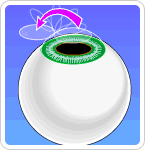
After your eye is numbed using an “eye drop” anesthesia, an eyelid holder is put in place to prevent blinking. Next, a device called a microkeratome makes a thin protective flap of the outer layer of the cornea, which is gently folded back.
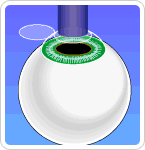
The laser radar beam “locks on” to the eye, constantly checking the eye’s movements to know the exact location of the vision correction area. While you relax, a small-spot laser “ablates”, or removes, tiny amounts of corneal tissue, gently shaping the inner layer of the cornea to match your vision correction requirement.
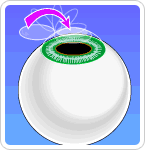
When the ablation process is complete, the protective flap of the cornea is folded back into place. After the surgery, you will be given doctor’s instructions to follow for recovery.
How LASIK works
Click here to see an interactive demonstration about how LASIK can treat common vision problems like nearsightedness, farsightedness or astigmatism.
What is involved in the PRK procedure?
The doctor will take a picture of your eye to help the laser to determine the exact dimensions of your eye. You will be taken into the Allegretto Wave suite. You will lie down on the table, as the doctor looks into your eye through a microscope. The Allegretto Wave system will confirm the parameters of your eye, matching it to the photograph taken previously. After your eye is numbed using an “eye drop” anesthesia, an eyelid holder is put in place to prevent blinking. Next, the doctor gently removes the epithelium with a micro-spatula. The laser radar beam “locks on” to the eye, constantly checking the eye’s movements to know the exact location of the vision correction area. While you relax, a small-spot laser “ablates”, or removes, tiny amounts of corneal tissue, gently shaping the inner layer of the cornea to match your vision correction requirement. When the ablation process is complete, a soft bandage contact lens is placed on the eye. After the surgery, you will be given doctor’s instructions to follow for recovery.
Frequently Asked Questions
How long does the treatment take? How long will recovery be?
The laser treatment itself takes about 15-90 seconds, based on the degree of correction necessary. Sometimes, only one eye is treated at a time. Typically, you’ll notice improved sight the next day following the treatment, and can usually go back to work in two days. Often patients prefer to be treated on a Thursday afternoon to minimize time away from work.
How do I know it’s safe?
The excimer laser has been proven to be safe and effective for the treatment of the great majority of nearsighted prescriptions. In the U.S. clinical trials’ three-year follow-up, no sight-threatening complications have occurred. Millions of laser treatments have been performed in the U.S. over the past five years. As added proof, some of the nation’s top eye institutes are working with an independent medical council on an ongoing basis to ensure that the highest standards of safety are met.
Will I be in any pain?
The treatment itself is painless. Typically, people experience discomfort and a “gritty” feeling during the 24-48 hours after the treatment with PRK, but not LASIK. Patients who are treated will be given medication they can use to control any discomfort they might experience.
What are the side effects?
The most common side effects are a “halo” effect and some glare at night around lights. However, these problems are no worse than what most contact lens and eyeglass wearers often experience. In addition, the eyes will tend to be drier than usual and may need artificial tears afterwards.
Will the treatment be permanent?
Given the results of the U.S. clinical trials and the results reported internationally, the treatment appears to be permanent.
Can I afford the treatment?
Eyeglasses usually have to be replaced once a year or so. And contact lenses can be extremely costly, especially when you add in the cost of solutions. You’ll find that laser correction of nearsightedness can probably pay for itself in a few years’ time. Although laser is covered by insurance in some cases, it is not common because many insurance carriers consider it an elective surgery. Financial counseling and payment option information is available through our business office.
